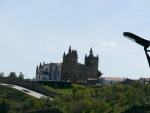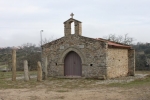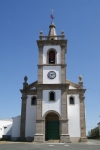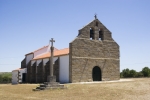DirectoryENG
Description: Chapel in ruins which the only remains are the walls and the main chapel. Nearby the visitors can find the two places excavated in the rock.
Date: 13th/ 16th / 18th centuries.
Valuation: National Monument (Desde 16.06.1910).
Description: The Benedictine monastery of Castro de Avelãs enjoyed the protection of Afonso Henriques, exerting a decisive influence on the economy of this region in which it is implanted, at least until the 13th century. It was a very important monastic Centre in the northeast between the 12th and 16th centuries. The Church is situated between the ruins of the convent and the remains of a tower and friary. The old church was built and incomplete Romanesque mudejar Root Lion, with red brick, a material seldom used among us. This project was never completed, with three semicircular chapels, one of the towers of the facade and the beginning of the wall of the Hall, visible on the South side. In southern apsidal is a monolithic, composed of wild arc granite. The tomb is decorated with two coats of arms and a registration without end – “ERA DE MIL E CCC “- engraved on the cover.
State of conservation: good.
Location: Village of Castro de Avelãs
Legends and traditions: an old tradition says that the Tomb, stored inside one of the apses, belongs to D. Knight Pelayo, known as Earl of Ariães. According to the legend, this Earl led a victorious war against the incursions of the Muslims in D. Ramiro II, who loved the inhabitants of Bragança. The king proposed him to deliver the city if he was agreed to enter in a challenge with a Moor, but in unequal strength. Confident in his victory, the Earl accepted the challenge on the day of St. George, who pledged, in case of victory, to erect a chapel in his invocation that annually visit in procession. He defeated the enemy, at the edge of Ariães, and had built a temple in honour of St. George.
Source: Património dos Concelhos da Terra Fria Concelho de Bragança VOLUME I
Date: 16th, 17th and 18th centuries
Description: Ordered by D. João III, king of Portugal, the project begun in the ateliers in the capital, then altered and completed years later by the architect Miguel de Arruda and Spanish masters Francisco Velásquez and Pedro de La Faia. Works began in 1552 and ended in 1566. Until 1780 the cathedral was the center of all social, religious and cultural life in the City of Miranda do Douro. By then the pope decided to reunite the bishopric of Miranda with the city of Bragança. The interior of the temple presents body of three ships divided in five stretches.
The interior of the church is filled by gilded altars and altarpieces, from the national baroque till the beautiful paintings and sculptures of the 16th to 18th centuries. The main chapel was conclude in 1614 by the Spanish master Gregório Fernandez. The prominence goes for a magnificent Calvary of great dramatically tension. The exuberant baroque organ of 18th century still ascends in this magnificent environment of golden cut.
Classification: National Monument, Dec. 16-06-1910, DG 136 de 23 Junho 1910, ZEP, DG 185 de 09 Agosto 1957.
State of Conservation: Very Good
Legends and traditions: The cathedral is known for the legend of Menino Jesus da Cartolinha. The image is of Jesus as a child wearing a top hat and is dated from the late 17th century or early 18th century. The top hat dates from the 19th century. Legend says, that the city was invaded and pillaged by Spanish troops and while the Portuguese troops waited for reinforcements, a little boy very well dressed appeared and called all the inhabitants to rise and fight against the Spanish. People with rustic weapons united and fought the invaders away. During the battle the boy would appear and disappear and after the victory was declared he was never seen again. The little “general” had vanished. People said it had been a miracle and that the victory was due to the little boy Jesus. In his honor, an image of Little Boy Jesus dressed as a noble knight was made and placed on an altar in the cathedral.
Source: http://www.infopedia.pt/$se-catedral-de-miranda-do-douro
Date: Modern Age (the primitive church would be of century XV).
Description: the facade is coated with modern tiles. The vestibule is decorated with sheled form, which opens to a grand window. The interior altars are of polychromatic woodwork.
State of consertation: good
Legends and Traditions: the pilgrimage Senhor de Cabeça Boa occurs in the 1st Sunday of May. Certain day, a Portuguese emigrant in Brazil was lost at sea and asked for the aid the Saint Christ, promising to build a temple to it if he was saved. Thus the chapel of Saint Christ was born, where the arrival of the Christianity to lands of Vera Cruz is celebrated. Other story says that in the darkest night, the lamp suspended in the chapel is sighted in the distant mountain ranges.
Location: Samil, Bragança
Source: Património dos Concelhos da Terra Fria Concelho de Bragança VOLUME II
Dating: 16th century (1509).
Description: Chapel of small proportions. In the chancel are kept some ex-votes of wood with polychrome.
State of conservation: good.
Location: Grijó de Parada, Bragança
Source: Património dos Concelhos da Terra Fria Concelho de Bragança VOLUME II
Dating: Modern age
Description: Chapel with walls covered with fresh paintings that represent scenes of the Passion of Christ, such as the last Supper, the Calvary and the Crucifixion.
State of conservation: very good
Dating: 17th century Chapel remodeled in the 18th century
Description: Baroque church consisting of a single ship and rectangular chapel and sacristy. The main façade, of granite, was projected by Damião Bustamante. The main chapel was paved with granite, a presbytery of three steps and a altarpiece with a panel that represents the “Invention of the Santa Cruz”, by Damião Bustamante.
State of Conservation: Very good
Dating: apparently medieval, was reconstructed in the 90’s (20th century)
Description: Small chapel with vestibule in arc, topped by a tower bell without bell. The interior ship is separate from the mail chapel by a cruise. Before its reconstruction the chapel was abandoned and used as shelter for the animals.
Dating: it may have been built or rebuilt in 1757.
Description: access to this large temple is done by a wide staircase. In the churchyard there is a church garden sink of holy water from the ruined Chapel of Santa Eulalia, where is said to have existed in the town of Medea. In the grand facade stands out the high Bell Tower of three records. Inside there are 9 altars carved polychrome; a pulpit; the baptistery of granite and the high altar with the national arms.
State of conservation: good.
Legends and Traditions: a house in the Fountain of the Moor Street, in the neighborhood of Pereiro, the memory remains the site of the old parish church. It is a stone with the date 1622. The main religious festivals of this village are from São Sebastião (on the 3rd Sunday of January), St. Apolinário (the last Sunday in July) and Nossa senhora da Assunção (15th of August). Here also conducts a biweekly (Wednesday) fair (8 and 26 of each month) and an annual fair (December 8).
Source: Património dos Concelhos da Terra Fria Concelho de Bragança VOLUME II
Dating: 16th century
Description: It is a church of one ship. The headboard is raised above the main structure of the church. The images of Senhor da Piedade and Senhora da Soledade are workmanship of 18th century baroque cut. It possesses different remains of 16th century paintings.
State of Conservation: very good
Location: Duas Igrejas, Miranda do Douro
Legends and Traditions: According to legend of the Senhora do Monte, the Virgin Mary asked a little shepherd girl to inform the inhabitants of the place where they should build a temple in Her honor. The date of this appearance is of 1902. The 15th of August is the annual pilgrimage.










